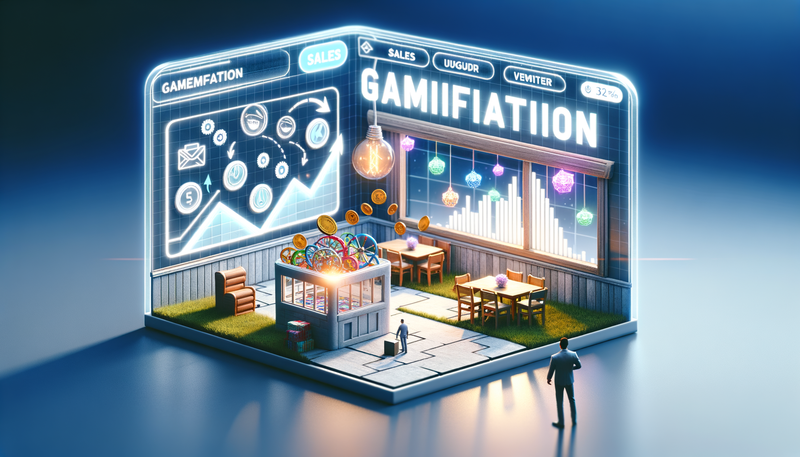Using Gamification to Increase Engagement and Drive Sales on Your Website
Gamification has emerged as a powerful tool for businesses looking to enhance user engagement and drive sales on their websites. By incorporating game-like elements into the user experience, companies can create a more interactive and enjoyable environment that encourages customers to spend more time on the site, make purchases, and return for future visits. This article explores the concept of gamification and its application in e-commerce, highlighting various techniques and strategies that businesses can implement to boost engagement and conversions. From loyalty programs and challenges to interactive product exploration, we'll delve into effective gamification methods that can transform your website into a captivating and rewarding destination for your customers.Table of Contents:

Understanding Gamification in E-commerce
Gamification in e-commerce refers to the integration of game-like elements and mechanics into a website's design and functionality to enhance user engagement and motivation. By tapping into the natural human desire for competition, achievement, and rewards, gamification can create a more immersive and enjoyable shopping experience.This approach can lead to increased time spent on the site, higher conversion rates, and improved customer loyalty. Some common gamification elements include points systems, leaderboards, badges, challenges, and progress bars. When implemented effectively, these features can transform a standard e-commerce site into an interactive and addictive platform that keeps customers coming back for more.
Do you need a website? Want to build a website but don't know where to start? Our website builder is the perfect solution. Easy to use, and with the ability to customize to fit your business needs, you can have a professional website in no time.
Implementing Loyalty Programs
One of the most effective gamification techniques for e-commerce is the implementation of a loyalty program. These programs reward customers for their continued patronage, encouraging repeat purchases and fostering a sense of brand loyalty. A well-designed loyalty program can include various gamified elements, such as:1. Point systems: Customers earn points for purchases, reviews, or referrals.
2. Tiers or levels: Users progress through different status levels as they accumulate points.
3. Exclusive rewards: Unlock special discounts, early access to sales, or unique products.
4. Challenges: Complete specific tasks or purchase goals to earn bonus points or rewards.
By incorporating these elements, businesses can create a sense of progression and achievement, motivating customers to engage more frequently with the brand and make additional purchases to reach higher tiers or unlock exclusive benefits.
Creating Engaging Challenges and Contests
Challenges and contests are powerful gamification tools that can significantly boost user engagement and drive sales on your website. These interactive elements tap into people's competitive nature and desire for achievement, encouraging them to participate actively in your brand experience. Some effective challenge and contest ideas include:1. Seasonal scavenger hunts: Hide special products or discounts throughout your site for users to find.
2. Limited-time flash sales: Create urgency with countdown timers for exclusive deals.
3. User-generated content contests: Encourage customers to submit photos or videos featuring your products.
4. Quizzes and trivia: Test users' knowledge about your products or industry.
By offering rewards such as discounts, exclusive products, or recognition, you can motivate users to participate in these challenges, increasing their time on site and likelihood of making a purchase.
Building a website with SITE123 is easy
Enhancing Product Exploration with Interactive Elements
Interactive product exploration is a gamification technique that can make the shopping experience more engaging and informative for customers. By incorporating game-like elements into the way users discover and learn about products, you can increase their interest and likelihood of making a purchase. Some effective ways to gamify product exploration include:1. 360-degree product views: Allow users to rotate and examine products from all angles.
2. Virtual try-on experiences: Use augmented reality to let customers virtually test products.
3. Mix-and-match features: Enable users to combine different products or customize options.
4. Product quizzes: Guide users to the perfect product based on their preferences.
These interactive elements not only make the shopping experience more enjoyable but also help customers make more informed decisions, potentially reducing return rates and increasing overall satisfaction.
Leveraging Progress Bars and Achievement Badges
Progress bars and achievement badges are simple yet effective gamification elements that can significantly enhance user engagement on your website. These visual indicators tap into the human desire for completion and recognition, encouraging users to take specific actions or reach certain milestones. Here's how you can implement these features:1. Profile completion: Use a progress bar to show how complete a user's profile is, encouraging them to add more information.
2. Purchase milestones: Award badges for reaching specific spending thresholds or number of orders placed.
3. Review contributions: Recognize users with badges for leaving product reviews or helpful answers.
4. Wishlist goals: Show progress towards completing a wishlist or saving for a specific item.
By incorporating these elements, you create a sense of accomplishment and progression, motivating users to engage more deeply with your website and potentially make additional purchases to unlock new achievements.
Implementing Social Elements and Leaderboards
Incorporating social elements and leaderboards into your e-commerce website can create a sense of community and healthy competition among users, driving engagement and sales. These features tap into people's natural desire for social connection and status. Here are some ways to implement social gamification:1. Referral programs: Reward users for inviting friends to join or make purchases.
2. Community challenges: Create group goals that require collective effort to achieve.
3. User-generated content galleries: Showcase customer photos and videos featuring your products.
4. Leaderboards: Display top customers based on points earned, purchases made, or other metrics.
By fostering a sense of community and friendly competition, these social gamification elements can encourage users to engage more frequently with your website and motivate them to make purchases to improve their standing within the community.





